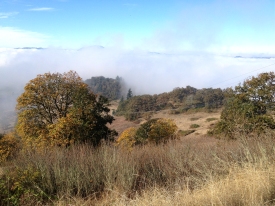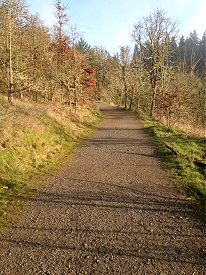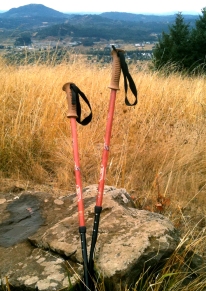 Last week I took advantage of a cool, clear day to head for the hills. During winter months in western Oregon, such days are at a premium, not to be wasted.
Last week I took advantage of a cool, clear day to head for the hills. During winter months in western Oregon, such days are at a premium, not to be wasted.
Just at the edge of town, a popular county park beckons me. Trails wind up the slope about 1.5 miles to a soft, open bluff with views on such cloudless days to the snow-capped Cascades in the east and the Coast Range on the west.
Midway up the climb, a voice stopped me. “That’s quite a pace you’re setting,” observed a man who appeared to belong to more or less the same generation as I.
I offered a nod of appreciation and continued the climb to the top. He stayed on my heels.
“Well, you appear to be doing just fine, as well,” I commented as we paused to take in the view at the summit. We chatted long enough for me to learn his age (78) and his motivation (skiing).
The walks are a means to an end for him—preparation for his real passion which lies in swooshing down snowy slopes.
Walks are a means to an end for me, too.
Make no mistake, I love to walk. But the end I seek is not a mountain peak. The motivation that sustains my momentum day after day comes from the boost these steps deliver to my body, brain and spirit.
Mounds of research tout the benefits of walking, all of it encouraging us to make movement an essential component of healthy living at every age. The evidence is convincing:
- 10 minutes of walking a day can make us more creative
- 10 minutes at a brisk pace can boost energy and mood
- Regular walks trigger neuron growth in the brain
 I’m grateful for these side-benefits of the steps I take with a brisk walk almost daily. But for me, nothing tops the psychological benefits of breathing in and breathing out. Fresh air in, Stale air out. Acceptance in, Letting go out.
I’m grateful for these side-benefits of the steps I take with a brisk walk almost daily. But for me, nothing tops the psychological benefits of breathing in and breathing out. Fresh air in, Stale air out. Acceptance in, Letting go out.
Over and over on walks, I focus on the simple, life-sustaining process of breathing. My walks become an active meditation as I welcome vitality and freshness and then let go of what’s used up.
It wasn’t always this way. The old track medals in a desk drawer attest to a time when mental clarity was a by-product, not a goal, of my walks.
Born in an era when girls were not welcomed into school athletic programs, I accepted early in life that I was good with words but not with balls. I took it as genetic fate. Even dancing was off limits in the context of my family’s faith. It was easier to define myself as a “klutz” than confront the boundaries of social and religious beliefs.
The competitive drive that might have gone into physical challenges instead propelled me into educational achievement and then through the learning curves of a journalism career.
Not until my mid-40s did I begin to question the assumptions that had kept me on the sidelines of the jogging movement and tennis matches. But when I met a woman who walked for exercise, my competitive spirit caught a whiff of a new challenge to explore.
At age 46, I entered my first track meet as a competitive race walker. It was a masters’ level meet for athletes aged 35 and over. I didn’t win any meals in that meet. Didn’t set any records. What I did was change my life.
Through five years of active competition, speed became my goal. The endorphin high was a side-benefit of the achievements that came my way.
When my interest in competition ended, I discovered that I had learned more than how to move my body. I had learned to use my mind.
As an athlete, I trained myself to focus on breathing to fuel my physical efforts, on words to control self-doubt and judgments when I raced, and on a mental image of myself as smooth and graceful. The tools of athletics and meditation merged.
 Now, at 72, it’s stability and balance, not speed, that I imagine as I step out for exercise. “Graceful, grounded, strong and tall,” I say to myself mentally a kind of chant that helps sets me off on a walk mindful of the path and of my posture.
Now, at 72, it’s stability and balance, not speed, that I imagine as I step out for exercise. “Graceful, grounded, strong and tall,” I say to myself mentally a kind of chant that helps sets me off on a walk mindful of the path and of my posture.
“Fresh air in, stale air out,” I may tell myself on other days, pairing the words with the inhalation and exhalations of my breath cycle.
When I near the final yards of a walk, my words turn to gratitude. “I give thanks for my feet. I give thanks for my knees. I give thanks for my lungs…” The list goes on for two or three minutes, reminding myself that this body still serves me well. Not with speed but with a strong, steady step as I move forward into whatever lies before me.

Leave a Reply